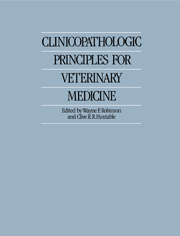Book contents
- Frontmatter
- Contents
- Contributors
- Preface
- Acknowledgements
- 1 The relationship between pathology and medicine
- 2 The immune system
- 3 The hematopoietic system
- 4 Acid–base balance
- 5 The respiratory system
- 6 The cardiovascular system
- 7 The alimentary tract
- 8 The liver and exocrine pancreas
- 9 The urinary system
- 10 The endocrine glands
- 11 The skin
- 12 The skeletal system
- 13 The nervous system
- 14 Muscle
- 15 Metabolic disease
- 16 The reproductive system
- Index
3 - The hematopoietic system
Published online by Cambridge University Press: 19 January 2010
- Frontmatter
- Contents
- Contributors
- Preface
- Acknowledgements
- 1 The relationship between pathology and medicine
- 2 The immune system
- 3 The hematopoietic system
- 4 Acid–base balance
- 5 The respiratory system
- 6 The cardiovascular system
- 7 The alimentary tract
- 8 The liver and exocrine pancreas
- 9 The urinary system
- 10 The endocrine glands
- 11 The skin
- 12 The skeletal system
- 13 The nervous system
- 14 Muscle
- 15 Metabolic disease
- 16 The reproductive system
- Index
Summary
The hematopoietic system is composed of a remarkable variety of cells. Included are those circulating in the blood and their ancestors in marrow and progeny in the tissues. Also included are cells whose function is to remove both senescent cells from the bloodstream and any foreign material, especially microorganisms that may gain entrance to the body. After birth, the major location for hematopoiesis is the bone marrow, and in the newborn animal all medullary cavities of the skeleton are given over to this purpose. As the demands of body growth subside, hematopoiesis normally retreats to the metaphyses of long bones and to the flat bones of the pelvis, ribs, calvarium and vertebrae. From here, it may re-expand if need be, both into the bony cavities and even into extraskeletal sites such as the liver, spleen and lymph nodes.
Hematopoietic stem cells are extravascular colonists in bone marrow and here they proliferate, differentiate and mature, being finally released as appropriately developed progeny into the circulation. These end cells have acquired sufficient membrane plasticity and movement to penetrate sinusoidal endothelium and leave the marrow.
The hematopoietic cell system consists of a hierarchy in which the progenitor stem cells are capable of unlimited self-renewal and multilineal differentiation, giving rise to all blood cell types via committed precursor cells (Fig. 3.1). Committed precursor cells have a limited capacity for self-renewal and differentiation. The control of stem cell differentiation is little understood but is apparently initiated by the interaction of helper and suppressor lymphocytes and modulated by hormones specific for each cell line (Table 3.1).
- Type
- Chapter
- Information
- Clinicopathologic Principles for Veterinary Medicine , pp. 38 - 84Publisher: Cambridge University PressPrint publication year: 1988



